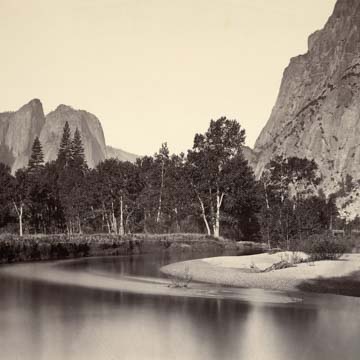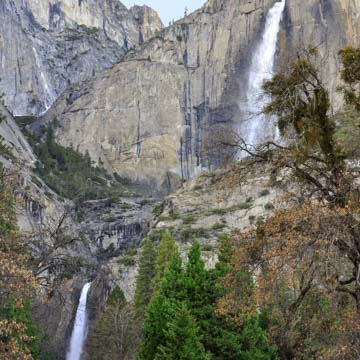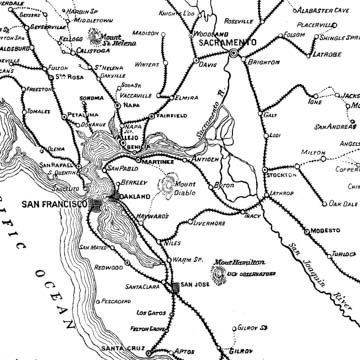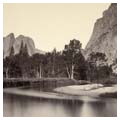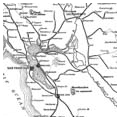Yosemite National Park covers 747,956 acres (1,168.681 square miles) and reaches across the western slopes of the Sierra Nevada mountain range, spanning the eastern portions of Tuolumne, Mariposa, and Madera counties in eastern central California. The Park is famous for its ancient giant sequoias, Bridalveil Fall, and the granite cliffs of El Capitan and Half Dome, which have inspired hikers, climbers, and photographers for generations.
Currently maintained by the National Park Service, Yosemite had been inhabited by Native Americans for over 3,000 years before its “discovery” by European American settlers. The Ahwahneechee were living in the Yosemite area when pioneers, led by explorer Joseph Rutherford Walker, came upon the site in 1833. After gold was discovered in the region in the following decade, miners flooded what is today Yosemite. During the Gold Rush era, conflict between the miners and tribes so escalated that a military expedition was dispatched in 1851 and the Mariposa Battalion under the leadership of James Savage pushed the Ahwahneechee off the land. Stories of thunderous waterfalls and towering stone columns soon spread throughout the region and in 1855 San Francisco entrepreneur James Hutchings organized the first tour to the valley. The construction of inns and roads followed in short order. In response, alarmed conservationists petitioned Congress to protect the land and in 1864 President Abraham Lincoln signed the Yosemite Grant. This legislation gave Yosemite Valley and the Mariposa Grove of Giant Sequoias to the State of California as a park. Thus was established the first portions of what would later become Yosemite National Park, one of the “crown jewels” of the National Park System. The lands were unified and designated the nation’s second national park on October 1, 1890, and in 1916, the newly formed National Park Service began managing the national park.
Yosemite National Park is renowned for its sheer cliff walls, dramatic waterfalls, giant sequoia groves, biological diversity, clear streams, and open meadows. It is a robust yet often challenged and contested landscape with a rich human and natural history. Within the park are multiple historic districts—including Camp Curry, Vogelsang High Sierra Camp, and the Mariposa Grove, as well as over thirty properties individually listed in the National Register. Also listed within the park are two archaeological districts (Yosemite Valley and El Portal) preserving sites used by prehistoric people, and five historic landmarks: the Ahwahnee Hotel, LeConte Memorial Lodge, Rangers’ Club, Parsons Memorial Lodge, and the Wawona Hotel and Thomas Hill Studio.
Yosemite’s establishment as a national park is closely associated with Frederick Law Olmsted and John Muir, two critical figures in American landscape history. Following the design of Central Park in New York (1858) and his work with the U.S. Sanitary Commission during the Civil War, Olmsted was hired by Governor Frederick Low to head the Yosemite Commission. In 1864, after Congress granted California the Yosemite Valley and the Mariposa Big Tree Grove, the commission was charged with surveying the lands and providing a plan for their use and protection. Olmsted’s report, Yosemite Valley and the Mariposa Big Trees, was written in 1865 and provided the requested information and guidance, but apparently it was never used and was subsequently lost until 1952. Nonetheless, and most importantly, it laid out the basic framework for managing national parks of the future. With respect to Yosemite, it focused on preserving the Valley and Big Tree Grove for succeeding generations while laying out a plan for visitor access through a modest road in the Valley, sensitively following the landscape’s major topographic features. These two aspects of the report—preservation and access—were written into the National Park Service Organic Act of 1916, and are known today as the agency’s “dual mandate.”
Muir’s involvement in Yosemite began in 1868, when he first visited the Valley and the surrounding landscape where he would live for the next three years. One of America’s fiercest wilderness advocates, Muir was actively involved in the protection of Yosemite’s pristine wilderness. In 1882, he co-founded the Sierra Club, became friends with important figures such as Ralph Waldo Emerson, Carleton Watkins, and Theodore Roosevelt, and worked as a national advocate for wilderness preservation throughout North America. Towards the end of his life, he became deeply embroiled in the failed attempt to protect the Hetch Hetchy Valley and stop the construction of the dam that enabled the valley’s flooding in the interest of supplying water to San Francisco.
Throughout Yosemite’s existence as a national park, its management has evolved almost continuously. During World War II, for example, the Ahwanhee Hotel, in the heart of the Valley, served as a hospital for recovering soldiers and sailors. Since its inception, the park has also been a prime destination for hikers and climbers, who are particularly attracted to Half Dome and the sheer wall of El Capitan, as well as to the many trails around the numerous waterfalls. Today over 800 miles of trails are available to hikers, in addition to extensive camping grounds. Activities including climbing, cross country and downhill skiing, and biking are also permitted inside the park.
Designated a World Heritage Site in 1984, Yosemite attracts approximately four million domestic and international annual visitors. Because of the significant impact of this level of visitation on the park’s natural and cultural resources, plans are regularly developed to reduce that impact through limited vehicle access, the closing of sensitive areas for a number of years, and other preservation actions as the park struggles to fulfill the National Park Service’s dual mandate of protection and access.
References
Duncan, D., and Yosemite Conservancy. Seed of the future: Yosemite and the evolution of the national park idea. Yosemite National Park, CA: Yosemite Conservancy, 2013.
Greene, L., and the National Park Service. Yosemite, the park and its resources: A history of the discovery, management, and physical development of Yosemite National Park, California. Historic Resource Study. Denver, CO: U.S. Dept. of the Interior, National Park Service, 1987.
National Park Service. The story of Yosemite's road system, Yosemite National Park, California.Washington, D.C.: U.S. Department of the Interior, National Park Service, 1992.
National Park Service. “Yosemite National Park.” U.S. Department of the Interior. Accessed February 22, 2016. www.nps.gov.
Runte, Alfred. Yosemite: The Embattled Wilderness. Lincoln: University of Nebraska Press, 1990.

